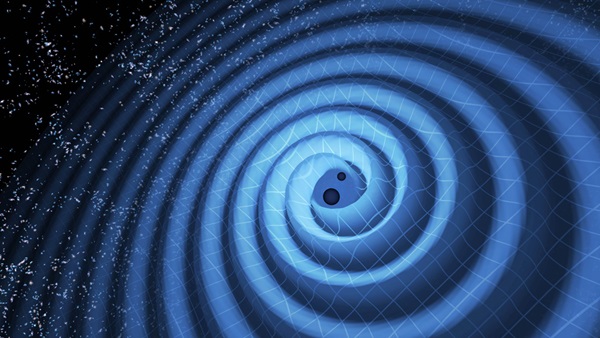Key Takeaways:
To get an estimate of the number of binary black holes that have the potential to blast gravitational waves across the universe, the LIGO scientists went back to a basic model of the evolution of the universe.
“Shortly after the beginning of the universe, the universe is very pristine, and it starts to make the first stars,” says Daniel Holz, associate professor in physics and astronomy at the University of Chicago and a co-author of the June 23 paper in the journal Nature. “We start our models there, and then we track what happens to the stars.”
What came out of the model was a collection of binary stars of the right size and composition to collapse into binary black holes with the right properties to spiral in toward a collision and close enough to Earth to be detected by LIGO with its projected sensitivity.
Holz’s co-authors on the paper are Krzysztof Belczynski of Warsaw University (lead author), Tomasz Bulik of Warsaw University, and Richard O’Shaughnessy of the Rochester Institute of Technology.
LIGO’s installations in Hanford, Washington, and Livingston, Louisiana, are currently shut down for upgrades and are scheduled to begin observing again in September. The primary upgrade between now and 2020 will be to gradually step up the laser power, thereby increasing the detector’s sensitivity.
Lucky for LIGO, the model contains the formation of lots of binary stars of all sizes.
“It turns out that most stars in the universe come in pairs,” says Holz.
Stars roughly 25 solar masses and below don’t form black holes, though some of the larger ones become compact neutron stars (and others, like the Sun, will someday become dense white dwarfs).
Those above 25 solar masses tend to collapse into black holes as small as five solar masses after they blow off the rest of their matter. Holz thinks there are many black holes in this regime (5-20 solar masses) that may be binary, but LIGO is less sensitive to them, so it only detects the few that are much closer to Earth.
In the intermediate range of black holes roughly 20-60 solar masses, Holz expects there are many binary black holes, and that is the sweet spot where LIGO will be able to see them to fairly large distances of thousands of megaparsecs. At the large end of the scale, very massive stars, which form very massive black holes, are more difficult to create, so there are very few of them, and the frequency of the gravity waves from their mergers is too low for LIGO to detect.
That leaves plenty of binary black holes for LIGO to observe.
Having a “target-rich environment” is part of LIGO’s success; the other part is to tune the LIGO detector to be at its most sensitive to detect what is out there.
“The main thing we find is that what LIGO detected makes sense,” according to Holz. The simulations predict the formation of black-hole binary stars in a range of masses that includes the two already observed on September 14, 2015, and December 26, 2015.
LIGO was designed, ironically, to have a “sweet spot” with binary neutron stars in mind. When the experiment was being designed, binary black holes were more theoretical. Binary neutron stars were a known phenomenon that astronomers could observe.
The first discovery of a binary neutron star — two neutron stars with one visible as a pulsar — was made in 1974. Joseph Taylor and Russell Hulse won a Nobel Prize for their discovery. A neutron star by itself is nearly impossible to detect, but if it has a companion, which can be an ordinary star or any other kind of star, it is much more likely to emit some form of radiation. A binary neutron star consisting of two pulsars was discovered in 2003.
There are six known binary neutron star systems in our galaxy, according to an article by Alexandra Witze in the Feb. 16, 2016, Nature. A pair of pulsars was used to indirectly confirm the emission of gravitational waves in the late 1970s by observing that the binary was falling into a tighter and faster orbit exactly as expected if it were losing energy by emitting gravity waves.
“It turns out, our models say LIGO is going to detect many fewer neutron stars compared to binary black holes,” says Holz, “so it’ll take us a while before we see our first binary neutron star.” Additionally, LIGO will only see a binary neutron star relatively nearby, within 300 million light-years, because the gravitational waves from merging neutron stars would be less powerful. The first detected binary black hole merger occurred about four times as far away.
Detecting black hole collisions and confirming Einstein’s predictions are thrilling, but what really gets Holz and his colleagues excited is discovering more about how these objects work. For example, with more data, they hope to detect the black holes’ spin.
“We’re learning not only about the formation of black holes, but we’re learning about the formation of stars, how stars are born, how they live their lives, how they die,” says Holz. “All of that is now available to us through these detections.”
Allen Zeyher is a freelance writer in the Chicago area.










